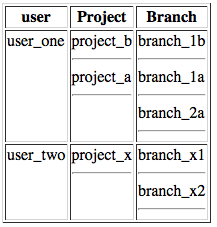I wrote this code:
tr = ""
for author, projects in data.iteritems():
tr + = "<tr><td>{}</td>".format(author)
for project, branches in projects.iteritems():
tr += "<td>{}</td>".format(project)
for branch in branches:
tr += "<td>{}</td>".format(branch)
tr += </td></tr>
end = "</table>"
I have this dataset
{
'user_one': {'project_a': ['branch_1', 'branch_2'],
'project_b': ['branch_1']},
'user_two': {'project_x': ['branch_x1', 'branch_b'] }
}
I want to print table like below:
+-------------------------------------------+
| User | Project | Branch |
+------------+---------------+--------------+
| user_one | project_a | branch_1 |
+------------+---------------+--------------+
| | | branch_2 |
+------------+---------------+--------------+
| | project_b | branch_1 |
+------------+---------------+--------------+
| user_two | project_x | branch_x1 |
+------------+---------------+--------------+
| | | branch_b |
+------------+---------------+--------------+
if its single project it works fine but when it comes multiple projects, it doesn't. I can get the result using PrettyTable but I since I want project_a, _b , _x etc to be hyperlinks. I cannot achieve it in while using PrettyTable, so I started writing my own html generator based on data.

